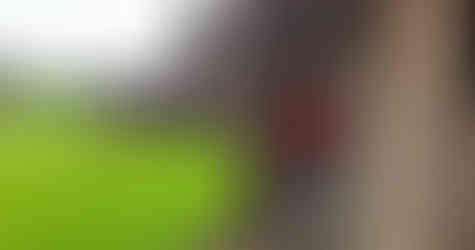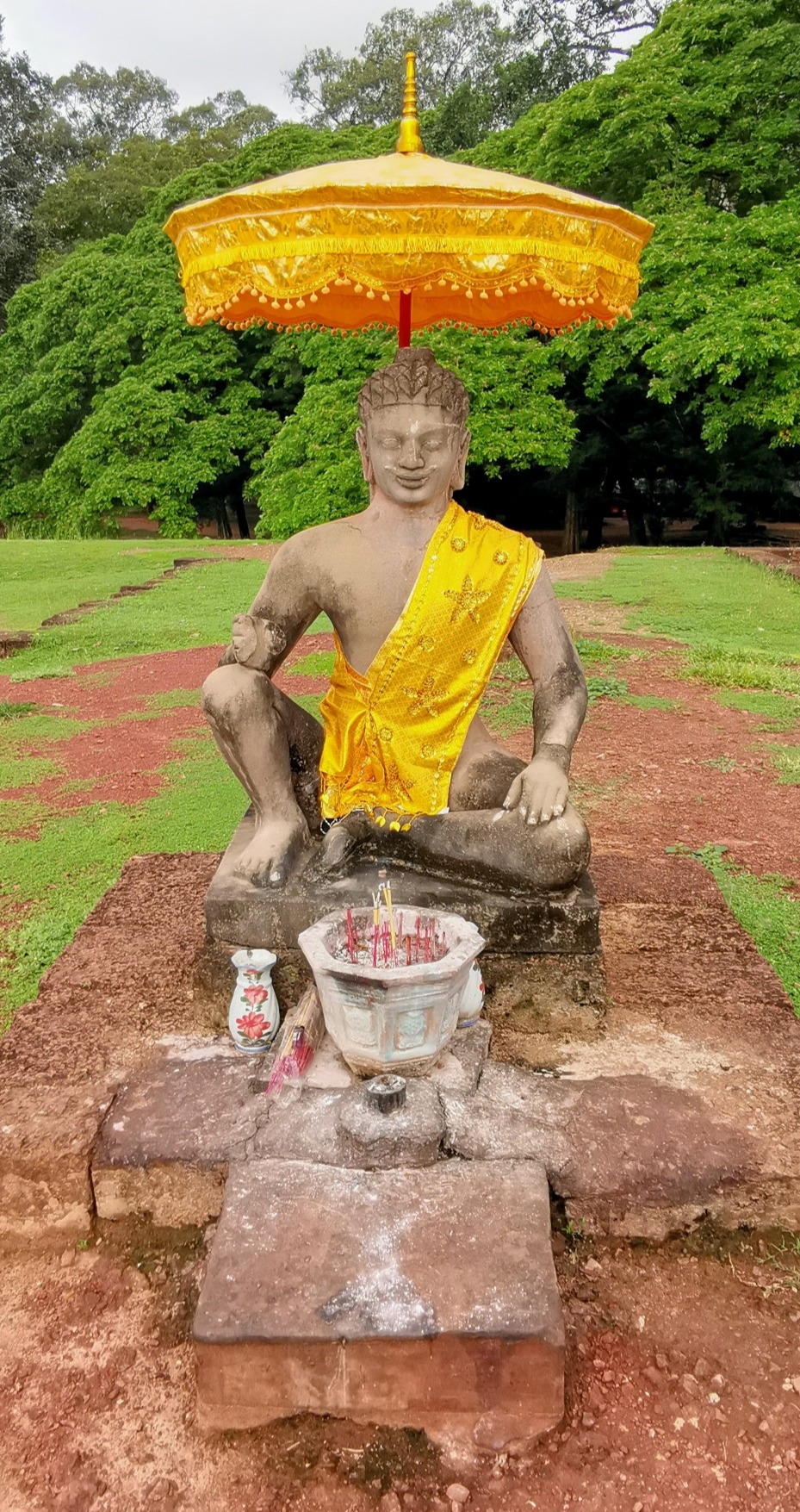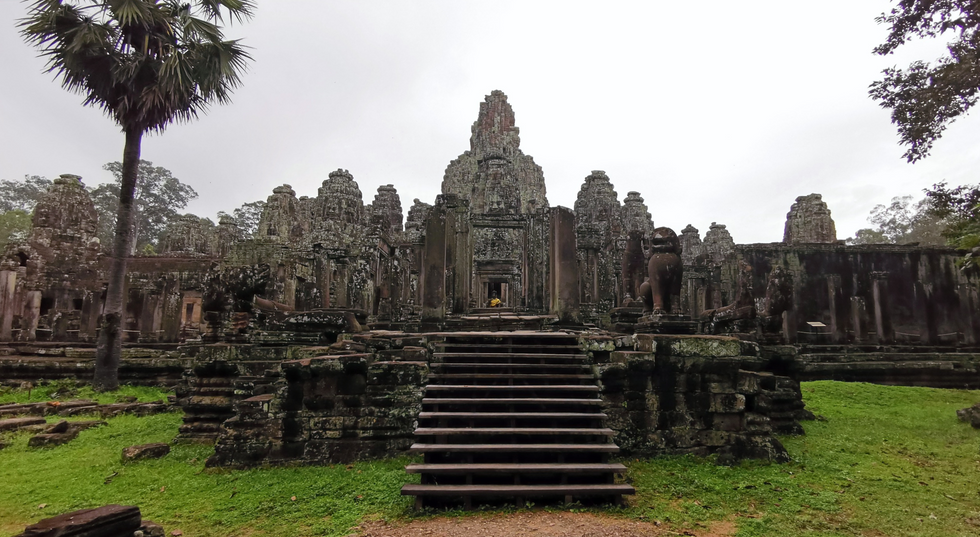Siem Reap: How to See the Best of Angkor in One Day
- MaxiMiserMom

- Sep 14, 2022
- 8 min read
Updated: Sep 15, 2022
Angkor Archaeological Park is a UNESCO heritage site stretching over 400 square kilometres. Angkor was the capital of the Khmer Empire, which began in 802 when King Jayavarman II proclaimed himself the universal ruler and collapsed in 1431 when the Khmers were driven out by the Siamese from the Ayutthaya Kingdom.
At the pinnacle of the Khmer Empire, from the 11th to 13th centuries, Angkor was the largest pre-industrial urban centre in the world with a population of around 700,000 to 900,000. Today, the remains in Angkor of numerous ornate temples with intricate carvings, crematorium, man-made reservoirs, hydrological engineering systems etc bear testament to the wealth and sophistication of the once mighty Khmer Empire.
Within Angkor, the ruins of 72 major temples and several hundred minor temples can be found, the largest of which is Angkor Wat. As much as I love history and visiting monuments, there're only that many temples I can take in a trip before I get templed-out. To distill the best places to visit, I poured over countless travel blogs, reviews, pictures, maps and itineraries of tour companies. Eventually, I zeroed in on Angkor Doors and worked with them to create a bespoke sunrise to sunset tour of Angkor for our group of 10.

I corresponded with Chan Bunpheng of Angkor Doors over e-mail, and he was always prompt and thorough in his replies. The best way to see a place like Angkor is with a passionate guide with a strong command of English, and in depth knowledge of the area and its history. So rather than just looking at a pile of rubble, stories of the past can then be brought to life as we look at the ruins, sculptures, carvings and inscriptions together. From our exchange of e-mails, I was confident I had found the right guide for our group, and we were not disappointed when we finally met.
Bunpheng had been a guide for more than 2 decades. All that screeched to a halt when COVID-19 struck and tourism fell off a cliff. He returned to his farming roots to support his family the last 2 years; planting crops, rearing chicken and catching fish to put food on the table. With tourism gaining traction again in Siem Reap, he was proud to don his beige official Angkor tour guide uniform once more and show us the best of his hometown.
For our group of 10, Bunpheng charged USD150.00 (i.e. USD15.00 per person) for a tour which lasted from sunrise to sundown, with a 2.5-hr siesta break from 1130 to 1400 hrs. We travelled in an air-conditioned 25-seater bus with a driver at our beck and call, who kept the bus clean and with an endless supply of chilled bottles of water. Admission fees to Angkor were not included, so we paid for our 1-Day Angkor Pass separately.
This was our itinerary for our sunrise to sunset tour:-
1. Watch the Sunrise from the Reflecting Pool at Angkor Wat
At 0430 hrs, Bunpheng met us at our hotel lobby. The drive to the ticket office for Angkor Pass took 15 mins, and we arrived there before they opened for business at 0500 hrs. I can imagine that, at peak season, the queue for passes would be horrendous. Bunpheng shared that, pre-pandemic, up to 10,000 tourists visited Angkor Wat per day; around half of whom would get up at an ungodly hour to watch the sunrise. Fortunately for us, there were few tourists around and we were at the head of the queue.
Three different passes were available for sale: 1-Day Pass (USD37.00), 3-Day Pass (USD62.00) and 7-Day Pass (USD72.00). Each ticket booth had a sign indicating the type of pass it sold.
A booth which sold 7-Day Passes, for instance, would only issue 7-Day Passes, and not 1-Day or 3-Day Passes. Be sure to join the correct line to avoid having to re-queue.
The ticket booths accepted both USD and credit cards. They were very strict about taking in only bank notes which were new, not creased and not marked, and would scrutinise every note. Our photos were taken at the booth and immediately printed onto the tickets.
After getting our tickets, we were driven to the west entrance of Angkor Wat, where we had to walk quite a distance in darkness to the Reflecting Pool in front of the South Library. We walked fairly quickly and got to the edge of the Pool at 0520 hrs. By then, the sun was already starting to emerge. Within 20 mins, we could see the clear silhouette of Angkor Wat against a sky awash with hues of purple, pink and apricot. Had we been stuck in the queue at the ticket booth, we would have missed it all.




Built in the early 12th century, Angkor Wat sits on 402 acres of land and is the world's largest religious monument. It was originally constructed as a Hindu temple dedicated to Lord Vishnu, but became a Buddhist temple by the end of the 12th century. The transition to Buddhism took place after Jayavarman VII became king in 1188. Prior to that, in 1177, Angkor was sacked by the Chams (people from what is now known as central Vietnam). It was King Jayavarman VII who successfully restored the Khmer Empire. He then made Buddhism a state religion because he felt the Hindu gods had failed him.

The original steps up the towers of Angkor Wat were extremely steep, a poignant reminder that the kingdom of the gods or heaven was very hard to reach. In ancient times, it was only possible to ascend those steps by climbing on all fours. Thankfully, new stairs have been installed over the original steps, making it possible for tourists to enter the towers.

We spent 3 hours exploring Angkor Wat, with Bunpheng telling us interesting stories of the carvings along the way.
2. Witness Mother Nature Reclaiming Manmade Structures @ Ta Prohm Temple (aka Tomb Raider Temple)
After stopping for breakfast, we moved on to Ta Prohm Temple, made famous by the movie Tomb Raider starring Angelina Jolie. Built in the late 12th to early 13th century, Ta Prohm was constructed as a Buddhist monastery and university.

Thick moss and lichen clung onto fallen stone structures, and the roots of enormous trees enveloped the ruins, swallowing the temple. It was sobering to witness the forces of Mother Nature at work, stamping out what mankind had arduously put together with the strongest of materials.
The most unique carving we came across in Angkor was that of what appeared to be a Stegosaurus dinosaur! Bunpheng pointed it out to us, just before we exited the temple.

After an hour at Ta Prohm, everyone in the group was pretty much tired. We had been up since 0400 hrs, and yearned to return to the hotel for a break. Some food, USD0.50 beer, a dip in the hotel pool or a nap; all sounded too good to resist.
Enroute to the hotel, we saw school children being dismissed for the day. Bunpheng pointed out to us that children attended public schools for free in Cambodia. Although kids would often approach tourists and cheekily say they had no money for school to try to get tourists to buy their postcards or whatever else they were selling, we should bear in mind that education in public schools is actually free!

3. Angkor Thom Southgate
Refreshed after a rest, we were picked up again from the hotel and made our way to Angkor Thom Southgate.
After Jayavarman VII was crowned king in 1188, he established Angkor Thom as his capital. Spanning an area of 9 square kilometres, Angkor Thom was protected on all 4 sides by a moat. The causeway crossing the moat south of Angkor Thom led to the Southgate. This causeway is flanked by 2 rows of statues, devas (heavenly being) on the left and asuras (enemy of the gods) on the right. Each row of statues is holding a naga (part cobra part human semi-divine being).


Our bus narrowly made it through Angkor Thom Southgate. Large vehicles like a 45-seater tour coach would not be able to enter Angkor Thom.

4. Bayon Temple
At the centre of Angkor Thom is Bayon Temple. Built in the late 12th century to early 13th century, it was the state Buddhist temple of King Jayavarman VII. The temple has 54 towers, with 4 faces carved on each side of the towers. There are altogether 216 faces and many scholars believe the faces are that of King Jayavarman VII himself. The same 4 faces can also be found atop Angkor Thom Southgate and Northgate.



Along the perimeter of Bayon, you'll find well-preserved carvings depicting what life was like during the Khmer Empire. A sizeable Chinese population had settled down in Angkor during that time and they fought alongside the Khmers against their enemies, the Chams. The Chinese had a distinctive hairdo, as they wore their hair up and had goatees. The Khmers had big earlobes, which according to Bunpheng, they still do today! The carvings gave invaluable insight into what ordinary life was like during the Khmer Empire, what life in the palace was like, how battles were fought and so on. We were mesmerized by the stories told by Bunpheng, and before we knew it, an hour had slipped by.


5. Baphuon Temple
Across the road from Bayon is Baphuon Temple. This temple pre-dates Angkor Wat, as it was built even earlier, in the mid 11th century. Initially dedicated to Lord Shiva, it transformed from a Hindu to Buddhist temple in the late 15th century.

Rain was pelting down when we arrived at Baphuon, interrupting a wedding couple's photo shoot, but the falling rain certainly gave the temple an aura of mystique. We passed Baphuon without exploring it, as it wasn't one with particularly distinctive features.
6. Terrace of the Elephants
Further along the way was Terrace of the Elephants. This viewing platform looked out towards the parade ground which extended towards Victory Gate. King Jayavarman VII used this terrace to look at his victorious army returning to Angkor Thom. What a glorious sight it must have been!

7. Phimeanakas Temple & the Royal Bathing Pools
Behind the Terrace of the Elephants was the entrance to Phimeanakas Temple, a Hindu temple built in the late 10th century. This was the oldest temple in our tour of Angkor. It was located within the walled grounds of the royal palace.
We passed through Phimeanakas without exploring it in detail, as it wasn't one with particularly interesting features either. What caught our attention though were the 2 large pools of water next to the temple. They are indicated in Google Maps as the "East Pond" and "Large Pond", but they didn't appear to be ponds to us. Bunpheng said they were royal bathing pools. We could see remnants of carvings at the side of the pools, and ancient steps leading down to them.

8. Terrace of the Leper King
Round the corner from the pools was the Terrace of the Leper King. The statue on the terrace is actually that of Yama, the Hindu god of death. When discovered, the statue was discoloured and had missing fingers, so it was given the nickname "Leper King".
As Yama's statue sat atop the terrace, his carvings were found all over the structure, and the shape of the structure was typical of ancient cremation grounds, experts believe that this was actually the site of the royal crematorium.
9. Palilay Temple
Hidden in the area behind Terrace of the Leper King is Palilay Temple. This off-the-beaten-track location receives very few visitors, and little is known about it. Even our driver didn't know the way to it! Bunpheng said this was one of his favourite temples because it is relatively well-preserved, always deserted, and like Ta Prohm, showcased the power of Mother Nature reclaiming her territory.

10. Watch the Sunset from Phnom Bakheng
I had researched thoroughly on the best spot for watching the sunset in Angkor, and concluded that the summit of Phnom Bakheng was the place to be. Unfortunately, heavy rain ruined our plans and we never got to witness the sunset from there.
I did make it to Phnom Bakheng at daybreak on my last morning in Siem Reap. It took about 25 mins to walk up to the summit at a leisurely pace.

At the break of dawn, the sight of Angkor Wat shrouded in mist from afar blew me away. I was immediately transported back to a different era, a different century. It was like a fairytale ending to my wonderful trip to Siem Reap.

I would love to return to Phnom Bakheng to catch the sunset on another occasion. For now, I'm content with the gift the morning mist brought me on that special day.





































Comments